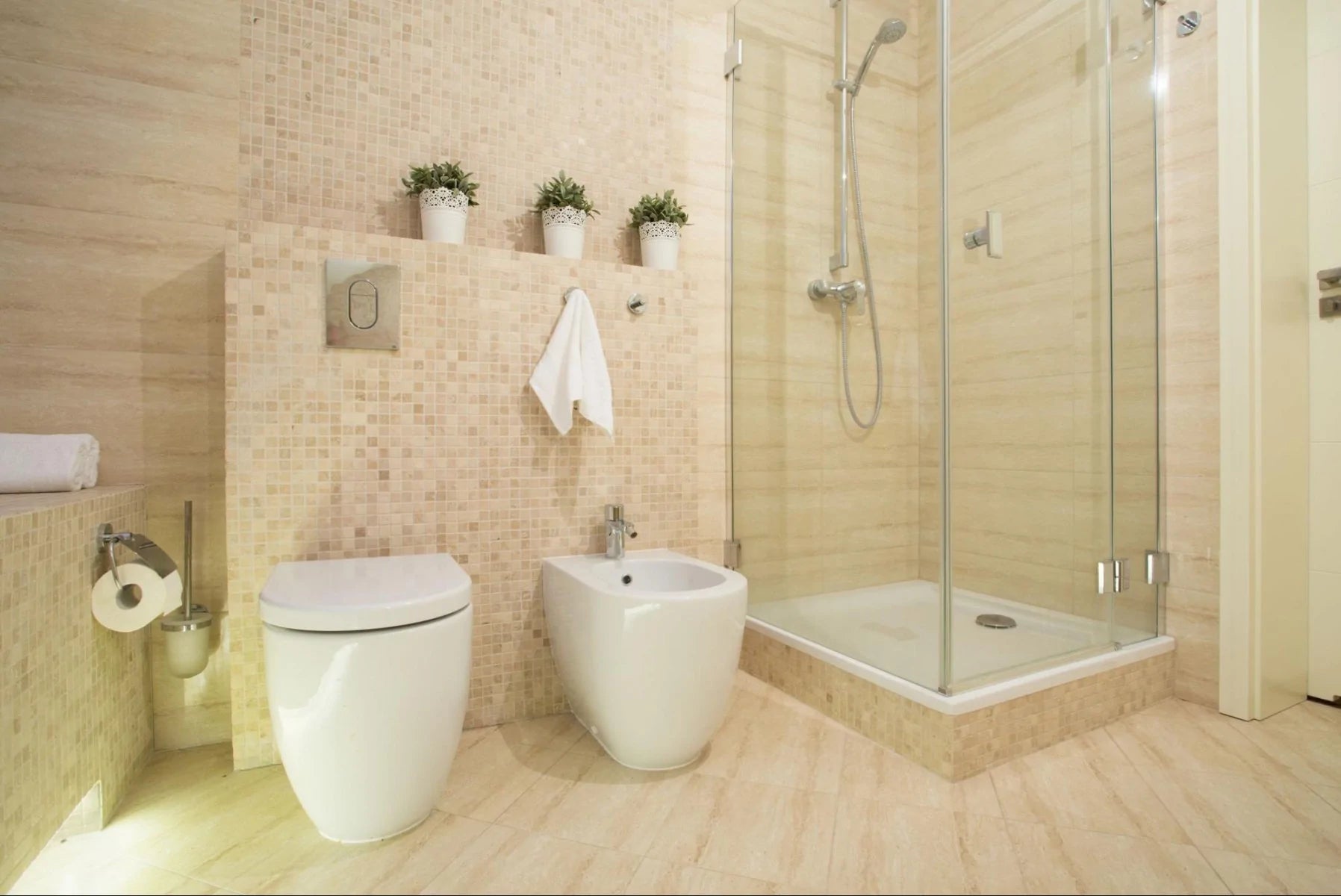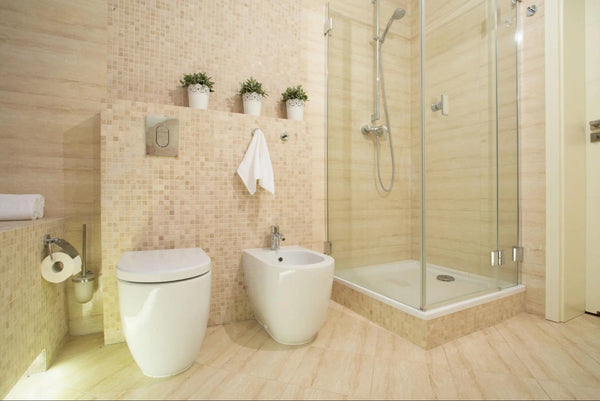Whether it’s around the toilet base or behind a faucet, bathrooms are filled with hard-to-reach nooks and crannies. This doesn’t pose a problem for most — until you try to dust or scrub, that is. But just because your bathroom is beautiful doesn’t mean it should be hard to clean. Here’s how to design a space that’s equal parts luxurious and low-maintenance.
Minimalist, Modern Fixtures
The best way to create a cleanable bathroom is to approach your design from a minimalist standpoint. Minimalist philosophy is all about reducing clutter and creating a more efficient space. Streamlined fixtures follow this principle. Cleaning is easier when there are fewer edges, corners and ridges to deal with, says the team at ATS Tiles and Bathrooms.
“As a general rule of thumb, the simpler the product and the more seamless, the better it is for cleaning,” they explain.
Since modern bathroom fixtures have a seamless style, they tend to be the best choice for keeping things clean. Take wall faced toilets, for example, with the cistern inside the wall. This popular modern toilet style sits flush against the wall, eliminating the dusty space behind the back of the toilet. Without this difficult-to-reach space to worry about, the bathroom is easier to clean.
Wall mounted sinks also have this benefit, as there’s less space behind a pedestal or vanity to collect dust and dirt. Sinks mounted on the wall also open up more floor space, making it easier to clean. With that open space around the pedestal, the entire bathroom floor can be cleaned with a sweep or a mop.
Smart toilets are another revolution when it comes to housekeeping, because they don’t need to be cleaned often. In addition to being flush against the wall, these high-tech toilets include a self-cleaning functionality, explains smart home strategist at HomeAdvisor, Dan DiClerico. “Smart toilets have features to minimize maintenance, including one that mists the bowl before and after each use to cut cleaning time in half,” he says.
Smart sinks, which are triggered by motion, can also save time on cleaning because they minimize smudges from fingers and soap. The bathroom faucet is one of the most touched areas in the house, meaning it also harbors germs and grime. Touchless sinks reduce the spread of bacteria and germs and minimize, the team at On The House writes. They explain how: “Their hands-free operation ensures that the faucet stays free of fingerprints, soap scum and toothpaste splatters. A wave of the hand starts the faucet — and you’re on your way to a tidier, maybe even immaculate, bathroom.”
Touchless sinks don’t just make it easier to wash your hands — they make using the bathroom cleaner and safer for everyone.

Grime-Free Tiling
Tile is timeless option in the bathroom, but standard designs aren’t always the best for maintaining a clean look. Dirt, grime and dust love clinging to tile grout, which can quickly turn yellow over time, Real Simple’s Lauren Phillips explains. “Stained or aging grout is often the primary culprit in bathrooms that don’t look as clean as they should, so reducing how much is visible can partially fix the problem,” she adds.
That’s why it’s best to avoid visible grout as much as possible. This doesn’t mean you have to forgo tiling entirely, however. Opting for tiles made of glass or waterproof stone tiles, for example, help achieve this look. Glass tiles also help keep your bathroom clean and fresh because they’re naturally resistant to humidity and moisture.
This means your tiles will resist collecting stains, mildew and mold, says Annabelle Bernard Fournier at The Spruce. The durability of glass is another selling point. While it is prone to scratching, it holds up well over time and can be cleaned with a simple spray of household cleaners.
Plus, glass tiles come in a variety of shapes and sizes, including large sheets that require little grouting. ZeroEnergy Design owner Stephanie Horowitz agrees that large tiles with narrow grout lines are a low-maintenance option. “It’s a fresh, modern look that requires minimal upkeep.”
Larger tiles have the added perk of making a bathroom feel bigger than it actually is, so small bathrooms can benefit in more ways than one. For bathroom flooring, similar principles apply. Bathroom floors can be especially dirty and prone to staining, so it’s important to choose tile that requires minimal maintenance.
The finish of the tiles is just as important as the size, because it’s the finish that determines how much stains show. Matte finish tiles are one of the most low maintenance bathroom flooring options that exist, says Sarah Kielbasiewicz at Wholesale Domestic Bathroom. “This texture tends to be more forgiving on imperfections like dirt, smudges and water spots. They generally don’t need to be cleaned as frequently as glossy tiles,” she explains.
Kielbasiewicz adds that if you do choose small floor tiles that require grout, dark colors are the way to go. Dirt is less visible on darker grout, so small accumulations of dust and grime won’t be visible.
Porosity is another factor to consider, especially when choosing shower and bathroom floor tiles. The easiest materials to clean are those which have few places for mold spores to collect and flourish. Since most showers are used every day, it’s important to invest in a high quality material that won’t scratch or crack and create room for mildew, says landscape builder Chris Deziel.
Fiberglass and acrylic, for example, are both nonporous and featureless. In contrast, natural stone like marble and quartz tend to be much more porous, meaning they’re prone to collecting mineral deposits.

Simple Showers
Showers are one of the biggest sources of grime and mildew in the bathroom, and this buildup can be tough to clean. This is why it’s important to consider cleanliness when choosing a shower design. Walk-in showers and those without curbs and frames are much easier to clean, according to Bubbles Bathrooms.
While there are many types of walk-in showers, the most popular designs feature either a curbless shower with minimal glass door, or a glass shower screen and no door.
But what about these showers is so low-maintenance compared to their traditional counterparts? The primary reason is because frameless shower doors have less hardware, says architecture and design writer Amanda Pachniewska. “This is because the absence of metal frames and caulking eliminates all the nooks and crannies where mold can develop and grime can accumulate.”
She adds that frameless shower doors do require a minimal amount of upkeep. Shower screens and frameless shower walls require just a quick squeegee on a daily basis. This minimal daily upkeep prevents water from leaving marks and stains on the glass. Reducing buildup in your day-to-day maintenance routine minimizes the need for heavy duty cleaning time later on.
Regardless of which style shower you choose, moisture in the bathroom is inescapable. To reduce instances of stubborn (and sometimes dangerous) mold and mildew in the bathroom, factor an efficient ventilation system into your design. According to Degnan Design-Build-Remodel, a fan or even an open window can ensure enough fresh air flow to prevent these undesirables from growing. “Proper ventilation is a preventative measure that can save you significant time spent cleaning in the long run,” they explain.
Images by: Katarzyna Białasiewicz/©123RF.com, Katarzyna Białasiewicz/©123RF.com, RawPixel/©123RF.com







